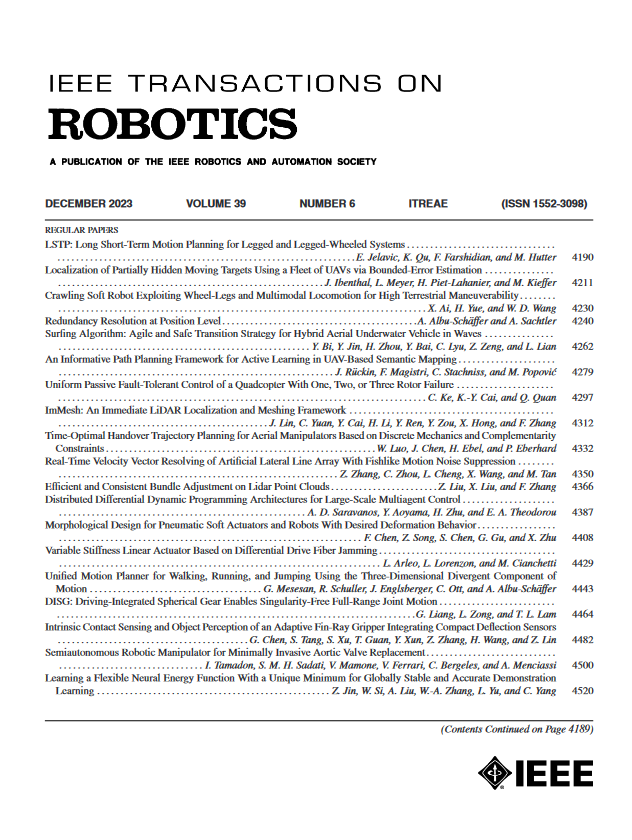原始蜂群:一个超轻量级和可扩展的大规模空中蜂群规划器
IF 10.5
1区 计算机科学
Q1 ROBOTICS
引用次数: 0
摘要
由于计算效率和可扩展性之间的内在矛盾,实现大规模的空中蜂群是具有挑战性的。本文介绍了一种超轻量级、可扩展的规划器——primitive-swarm,它是专门为大规模自主空中蜂群设计的。该方法采用分散式异步重规划策略。其中包含一个新颖的运动原语库,由时间最优和动态可行的轨迹组成。它们是利用一种基于可达性分析的新型时间最优路径参数化算法生成的。然后,通过将运动原语与离散的周围空间相关联,建立了快速碰撞检测机制。该机制考虑了空间冲突和时间冲突,同时处理机器人与障碍物和机器人与机器人之间的碰撞。然后,在重新规划过程中,每个机器人根据用户定义的需求从库中选择安全且成本最小的轨迹。离线计算时间最优运动原语库和占用信息,将耗时的优化问题转化为线性复杂度的选择问题。这使得规划器能够全面探索充满众多障碍物和机器人的非凸、不连续的三维安全空间,有效地识别最佳隐藏路径。基准对比表明,该方法在密集环境下的飞行时间和飞行距离最短,计算时间小于1 ms。超大规模的群体模拟,涉及多达1000个机器人,实时运行,验证了我们的方法的可扩展性。实际实验验证了我们方法的可行性和鲁棒性。该代码将被发布以促进社区合作。本文章由计算机程序翻译,如有差异,请以英文原文为准。
Primitive-Swarm: An Ultra-Lightweight and Scalable Planner for Large-Scale Aerial Swarms
Achieving large-scale aerial swarms is challenging due to the inherent contradictions in balancing computational efficiency and scalability. This article introduces primitive-swarm, an ultra-lightweight and scalable planner designed specifically for large-scale autonomous aerial swarms. The proposed approach adopts a decentralized and asynchronous replanning strategy. Within it is a novel motion primitive library consisting of time-optimal and dynamically feasible trajectories. They are generated utilizing a novel time-optimal path parameterization algorithm based on reachability analysis. Then, a rapid collision checking mechanism is developed by associating the motion primitives with the discrete surrounding space according to conflicts. By considering both spatial and temporal conflicts, the mechanism handles robot-obstacle and robot–robot collisions simultaneously. Then, during a replanning process, each robot selects the safe and minimum cost trajectory from the library based on user-defined requirements. Both the time-optimal motion primitive library and the occupancy information are computed offline, turning a time-consuming optimization problem into a linear-complexity selection problem. This enables the planner to comprehensively explore the nonconvex, discontinuous 3-D safe space filled with numerous obstacles and robots, effectively identifying the best hidden path. Benchmark comparisons demonstrate that our method achieves the shortest flight time and traveled distance with a computation time of less than 1 ms in dense environments. Super large-scale swarm simulations, involving up to 1000 robots, running in real time, verify the scalability of our method. Real-world experiments validate the feasibility and robustness of our approach. The code will be released to foster community collaboration.
求助全文
通过发布文献求助,成功后即可免费获取论文全文。
去求助
来源期刊

IEEE Transactions on Robotics
工程技术-机器人学
CiteScore
14.90
自引率
5.10%
发文量
259
审稿时长
6.0 months
期刊介绍:
The IEEE Transactions on Robotics (T-RO) is dedicated to publishing fundamental papers covering all facets of robotics, drawing on interdisciplinary approaches from computer science, control systems, electrical engineering, mathematics, mechanical engineering, and beyond. From industrial applications to service and personal assistants, surgical operations to space, underwater, and remote exploration, robots and intelligent machines play pivotal roles across various domains, including entertainment, safety, search and rescue, military applications, agriculture, and intelligent vehicles.
Special emphasis is placed on intelligent machines and systems designed for unstructured environments, where a significant portion of the environment remains unknown and beyond direct sensing or control.
 求助内容:
求助内容: 应助结果提醒方式:
应助结果提醒方式:


